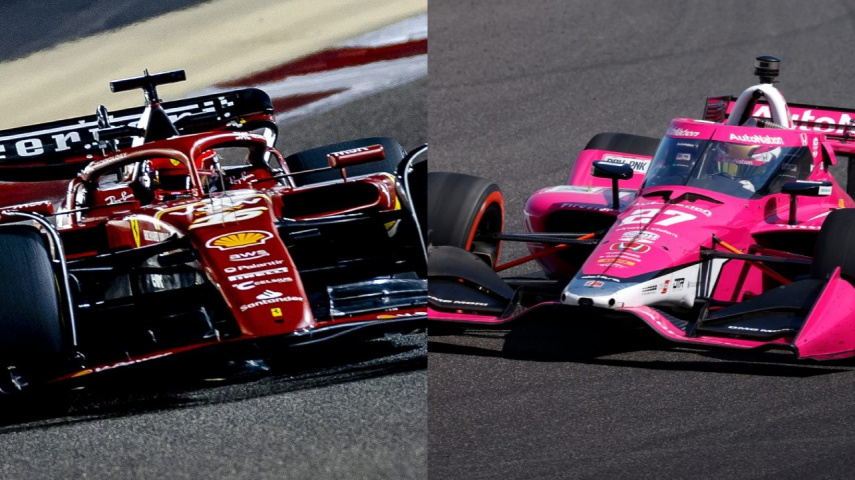F1 Vs IndyCar - 5 Major Differences Explained
All you need to know about the differences between Formula 1 and IndyCar.

The high-speed world of open-wheel racing showcases two premier championships: Formula 1 (F1) and IndyCar. Each possesses unique characteristics, thrilling fans worldwide. Despite their apparent similarities, they diverge significantly in several aspects, from the circuits they grace to the very machinery that tears through these tracks.
Dive into five key differences highlighting what sets these two premier racing series apart, ensuring enthusiasts and newcomers alike grasp their distinct flavors.
1. Locations

Formula 1 Racing Locations:
Formula 1 is renowned for its global championship status, visiting five continents over the span of its season, which includes around 23 Grand Prix events. This international footprint takes F1 to some of the most iconic and historic race tracks around the world, such as Silverstone in the UK, Spa-Francorchamps in Belgium, Monza in Italy, and Suzuka in Japan.
The diversity of locations and tracks in F1 is a testament to its global appeal and the high level of interest in different parts of the world. F1's reach extends to street circuits in glamorous cities like Monaco, Singapore, and Jeddah, adding to the spectacle and global allure of the sport. F1's season traditionally runs from March to November or December packing 24 races, offering a broader window for racing compared to IndyCar.
F1 notable races
British Grand Prix
- Location: Silverstone, UK
- Length: 190 miles or 52 laps of the 3.66 mile circuit
- Fast Fact: Tied with the Italian Grand Prix for the most installments held (73)
Italian Grand Prix
- Location: Monza, Italy
- Length: 190 miles or 53 laps on the 3.6 mile circuit
- Fast Fact: Monza has hosted the most Formula One Grands Prix, with 72 races hosted
IndyCar Racing Locations:
In contrast, IndyCar primarily focuses on the North American continent, with the majority of its races held in the United States. The series does venture into Canada for the Toronto race, marking its only current foray outside the U.S.
IndyCar's history includes international races, such as events in Brazil and visits to Europe during the CART era in the 1990s and 2000s, but its current schedule is largely U.S.-centric. The IndyCar season typically starts in late February and ends in early September, packing 17 races into a more compressed timeframe than F1's March to November/December schedule.
IndyCar's focus on American venues and the inclusion of oval tracks offer a unique spectacle, particularly with the high-speed oval racing that is rare in other forms of motorsport. On the other hand, F1's global circuit provides a wide-ranging test of driver skill and engineering prowess, with its races held in a variety of international locations that underscore its status as a world championship.
Indycar notable races
Indy 500
- Location: Indianapolis, Indiana
- Length: 500 miles or 200 laps of the 2.5 mile oval
- Fast Fact: Starting field expands to 33 drivers, opens space for guest drivers from other racing circuits like Formula One
Grand Prix of Road America
- Location: Elkhart Lake, Wisconsin
- Length: 222 miles or 55 laps of the 4.0 mile oval
- Fast fact: Home to the longest track on the circuit
2. Tracks

The differences between Formula 1 (F1) and the IndyCar Series extend into the types and variety of tracks they race on, highlighting the distinct characteristics of each motorsport discipline. Here's a detailed comparison of the differences in tracks between F1 and IndyCar:
F1 Tracks
Circuit Types: The F1 calendar predominantly features permanent race tracks known for their complex layouts and historical significance, such as Silverstone in the UK, Spa-Francorchamps in Belgium, Monza in Italy, and Suzuka in Japan. F1 also includes street circuits like Monaco, Singapore, and Jeddah, which are temporary tracks laid out on city streets, offering a unique challenge due to their often narrow and twisty nature.
- Permanent Race Tracks: F1 races on some of the most historic and challenging circuits in motorsport, including Silverstone (UK), Monaco, Monza (Italy), and Spa-Francorchamps (Belgium). These tracks are known for their rich history, technical challenges, and high-speed sections that test both driver skill and car performance.
- Street Circuits: F1 also features races on street circuits, such as Monaco, Singapore, Mexico, Vegas and the Jeddah Corniche Circuit in Saudi Arabia. Street races add a unique challenge due to their narrow, winding layouts and close barriers, requiring precision and focus from the drivers.
- Hybrid Circuits: Some tracks, like Albert Park in Australia and the Circuit Gilles Villeneuve in Canada, are not permanent facilities but are not typical street circuits either. They use public roads and parklands, offering a mix of characteristics.
Oval Tracks: Historically, F1 does not race on oval tracks, focusing instead on circuits that offer a mix of high-speed straights, challenging corners, and elevation changes.
IndyCar Tracks
Diverse Circuit Types: IndyCar's calendar is a mix of oval tracks, street circuits, and road courses. Oval tracks, such as the iconic Indianapolis Motor Speedway, make up about a quarter of the series, presenting a unique aspect of American motorsport with high-speed, banked turn racing. The remainder of the schedule includes street circuits, like Long Beach, and permanent road courses, such as Road America and Laguna Seca, offering a variety of racing experiences.
- Oval Tracks: A unique aspect of IndyCar is its inclusion of oval tracks, which make up about a quarter of its calendar. The most famous of these is the Indianapolis Motor Speedway, home of the Indianapolis 500. Oval racing requires a different set of skills and car setups, emphasizing speed, drafting, and strategic racing.
- Road Courses: IndyCar also competes on permanent road courses such as Road America in Wisconsin and Laguna Seca in California. These tracks challenge drivers with their elevation changes, high-speed corners, and technical sections.
- Street Circuits: Similar to F1, IndyCar races on street circuits, like the streets of Long Beach, California, and St. Petersburg, Florida. These races bring the action to city streets, creating exciting and unpredictable racing conditions.
Oval Racing: One of IndyCar's signature features is its inclusion of oval racing, which demands a different set of skills and car setups compared to road and street courses. The high-speed nature of ovals, with cars reaching speeds in excess of 230 mph, contrasts with the technical demands of road and street circuits.
Comparative Insights
- Formula 1: F1 tracks are renowned for their stringent safety standards and are often longer than IndyCar circuits, with lap lengths varying significantly. For example, the Circuit de Spa-Francorchamps is one of the longest in the F1 calendar at over 7 km. Tracks like Monaco are shorter but incredibly tight and twisty, testing drivers' precision and car handling. F1 cars are designed for high downforce, allowing them to navigate these complex circuits at high speeds.
IndyCar series quick stats:
-
Number of tracks: 45 tracks
-
Types of tracks: 24 ovals, 10 road courses, 10 street, 1 combined road
-
Countries: USA & CA
-
Average Length of tracks: 350 miles
F1 quick stats
-
Number of circuits: 75 worldwide, 40 with FIA grade to host F1
-
Types of circuits: street circuits, road circuits, race circuits, hybrid circuits
-
Countries : 34, including: Spain, France, Japan, Italy, Germany, USA,
-
Average Length of tracks: 190-192 miles
3. Cars

Both Formula 1 (F1) and IndyCar represent the pinnacle of motorsport in their respective arenas, yet they differ significantly in terms of technical regulations, race formats, and philosophies. Here's a detailed comparison under various subheadings to highlight their differences.
Chassis and Bodywork
Formula 1:
- F1 cars are designed with a focus on aerodynamics, downforce, and efficiency. Each team designs and builds its own chassis, subject to FIA regulations, leading to a diverse grid where engineering and design innovations play a crucial role in performance.
IndyCar:
- IndyCar uses a spec chassis provided by Dallara, the IR-18, ensuring that all teams have the same aerodynamic base. This approach emphasizes driver skill and team strategy over engineering capability, aiming to level the playing field and foster close competition.
Engine and Power Units
Formula 1:
- F1 employs highly sophisticated hybrid power units that include a 1.6 liter V6 turbocharged internal combustion engine (ICE) paired with an Energy Recovery System (ERS). The ERS consists of two motor generator units: the MGU-H (Heat) and the MGU-K (Kinetic), which recover energy from the car's exhaust and braking systems, respectively.
These power units can produce over 1000bhp, with the ERS contributing around 160bhp, usable for 33 seconds of a lap. The complexity and technology of F1's hybrid engines are unmatched, making them some of the most advanced in motorsport.
IndyCar:
- IndyCar uses 2.2 liter V6 twin-turbocharged engines supplied by Chevrolet and Honda. The engines are purely internal combustion without hybrid components, simplifying the technology and maintenance compared to F1's power units. This approach focuses on reliability and parity among competitors, with engines producing around 550-700 horsepower depending on the track configuration.
Aerodynamics and Performance
Formula 1:
- F1 cars are designed for maximum downforce and grip, allowing them to navigate corners at high speeds and achieve incredible acceleration. The intricate aerodynamics, including movable wing elements like DRS (Drag Reduction System), enable F1 cars to reach 0-100 km/h in approximately 2.6 seconds and top speeds of around 380 km/h in low downforce configurations.
IndyCar:
- While still aerodynamically advanced, IndyCar's standardized chassis and aero kits produce less downforce compared to F1 cars. The focus is on creating competitive racing with emphasis on slipstreaming and overtaking. Top speeds are similar to F1, especially on superspeedways, but the cars generally have slower cornering speeds due to the lower downforce.
Racing Format
Formula 1:
- Races are capped at around 305km or 2 hours, with one or two pit stops for tire changes. DRS zones enable the use of overtaking aids, and sprint qualifying sessions determine the starting grid.
IndyCar:
- Races last between 90 minutes to 2 hours plus 1 lap, with pit stops for new tires and fuel. The "push-to-pass" system gives drivers a temporary horsepower boost for overtaking.
While Formula 1 focuses on technological innovation, performance, and global prestige, IndyCar emphasizes close racing, driver skill, and strategy on a more standardized technical platform.
4. Schedule and point system

Formula 1
- Global Circuit: F1 boasts a truly global schedule, with the 2024 season featuring 24 races held on every continent except Antarctica. This international footprint brings the sport to a diverse audience and tests teams' logistical capabilities.
- Marquee Races: Races like the Monaco Grand Prix, the British Grand Prix at Silverstone, Las Vegas GP and the Italian Grand Prix at Monza are historic and prestigious events that draw significant attention from fans and media alike.
- Top Finishers: F1's point system awards points to the top 10 finishers, with a significant emphasis on higher placements. The winner receives 25 points, with a decreasing scale down to 1 point for 10th place. This system places a premium on top finishes.
- Fastest Lap Point: F1 awards an additional point for the fastest lap of the race, provided the driver finishes in the top 10. This encourages teams and drivers to push for performance throughout the race.
- Sprint Races: In select events, F1 holds sprint races, the 2024 season also includes six sprint races, offering additional points for the top eight finishers in these events, with 8 points for 1st place down to 1 point for 8th place.
In F1, the points system for placement works like this:
- 1st place: 25 points
- 2nd place: 18 points
- 3rd place: 15 points
- 4th place: 12 points
- 5th place: 10 points
- 6th place: 8 points
- 7th place: 6 points
- 8th place: 4 points
- 9th place: 2 points
- 10th place: 1 point
- 11th-20th place: 0 points
- Variety: IndyCar's schedule features a diverse mix of track types, including ovals (short ovals and superspeedways), street circuits, and permanent road courses. This variety requires teams and drivers to excel across different racing disciplines.
- Key Events: The Indianapolis 500 is the crown jewel of the IndyCar series, held at the Indianapolis Motor Speedway. It is not only a race but a month-long series of events that captivate the city of Indianapolis and racing fans worldwide.
- Distribution: IndyCar awards points to all finishers, with a scale that decreases down the order. The winner receives 50 points, and points decrease incrementally down to 1 point for drivers finishing 25th and beyond. This system rewards consistency and participation across the season.
- Bonus Points: IndyCar offers bonus points for pole position, leading a lap, and leading the most laps in a race except in Indy 500. These incentives encourage competitive racing throughout the field.
- Double Points Races: Certain races, like the Indianapolis 500 and the season finale, may award double points, making them pivotal in the championship battle.
In IndyCar, the points system for placement works like this:
- 1st place: 50 points
- 2nd place: 40 points
- 3rd place: 35 points
- 4th place: 32 points
- 5th place: 30 points
- 6th place: 28 points
- 7th place: 26 points
- 8th place: 24 points
- 9th place: 22 points
- 10th-25th place: Starts at 10th place with 20 points, and every position back earns one fewer point down to 25th place with five points
- 26th-33rd place: 5 points
5. Budget and Accessibility

The financial and accessibility aspects of Formula 1 (F1) and IndyCar Series significantly influence their global appeal, team dynamics, and overall competition structure. Here's a detailed comparison:
Formula 1:
- Cost Cap Evolution: The introduction of a cost cap in F1 was a significant shift towards financial sustainability and competitive parity. Starting in 2021 with a cap of $145 million, it was reduced to $140 million in 2022, further dropping to $135 million in 2023. For 2024, despite an initial expectation to maintain the cap at $135 million, the increase in the race calendar to 24 races has led to an adjustment, raising the cap to $140.4 million.
- Capital Expenditure Allowance: This allowance is another strategic tool within the F1 financial regulations, permitting teams an extra $20 million spending in 2024 for facility improvements, showing the FIA's flexibility in accommodating teams' needs for competitiveness and operational efficiency.
- Challenges and Controversies: The cap's enforcement has not been without its challenges, notably Red Bull Racing's breach in 2021, resulting in a $7 million fine and restrictions on their aerodynamic testing.
. - Spending Before the Budget Cap: Before the implementation of the budget cap, F1 teams' spending varied widely, with top teams like Mercedes spending up to $450 million in 2020, highlighting the vast financial disparities that the cost cap seeks to address.
- The exclusivity and high costs associated with hosting an F1 race often mean that access to live events can be expensive for fans, potentially limiting in-person viewership to those who can afford it.
IndyCar:
- Cost Efficiency: IndyCar is generally perceived as more cost-effective than F1, with entire season budgets for top teams being in the range of $10 to $15 million, significantly less than even the reduced budgets of F1 teams under the cost cap regulations. This lower financial barrier facilitates a more level playing field, potentially allowing for more competitive balance across the grid.
- Team Ownership and Participation: The lower operational costs in IndyCar make team ownership and participation more accessible to a broader range of investors and racing professionals. This accessibility helps foster a diverse and competitive field, where smaller teams can more realistically challenge for victories and championships.
- Driver Opportunities: IndyCar's accessibility extends to drivers, where talent can often find opportunities based on merit, as opposed to the significant financial backing sometimes required to secure seats in F1. This dynamic contributes to a more varied driver lineup, with opportunities for talents from different backgrounds and levels of financial support.
- Development and Innovation: While F1's higher budgets allow for rapid technological advancements and extensive development, IndyCar's more modest financial model focuses on parity and driver skill. The use of standardized parts and limitations on development spending help maintain competitive balance and ensure that the series remains accessible to a wider range of teams and drivers.
- IndyCar primarily races in the United States, with occasional events in Canada, reducing travel and logistical costs for teams and fans alike.
- Ticket prices for IndyCar races are generally more affordable compared to F1, making it more accessible to a broader audience and fostering a strong fan base in North America.
The distinctions between Formula 1 and IndyCar highlight the diverse approaches to open-wheel racing, each with its own unique challenges and appeals. Whether it's the global spectacle of F1 or the intense competition of IndyCar, both series offer thrilling racing and have cultivated passionate fan bases around the world. Understanding these differences enriches our appreciation of what makes each series special.





 JOIN OUR WHATSAPP CHANNEL
JOIN OUR WHATSAPP CHANNEL



































































































